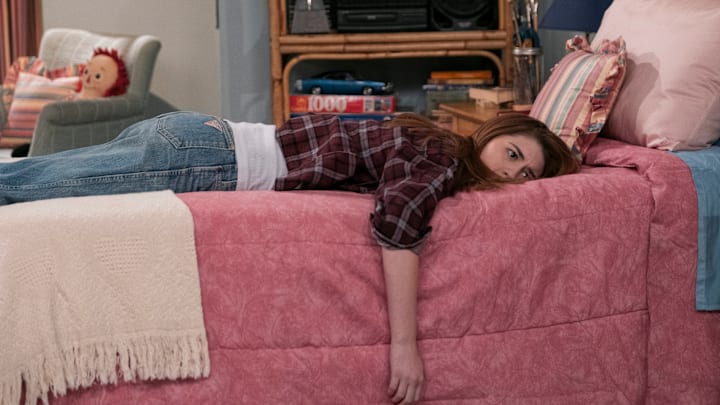The second season (or second part, according to how Netflix insists on numerating its original comedy series) of That '90s Show dropped on June 27 and invited us back for another summer in Point Place, Wisconsin. The sequel spinoff of That '70s Show again centers on Donna and Eric's teenage daughter Leia (Callie Haverda) hanging out with her friends in Red and Kitty's basement.
In the previous season (part?) finale, Leia almost kissed Nate (Maxwell Acee Donovan), a friend of her boyfriend Jay Kelso (Mace Coronel) and the boyfriend of her friend Nikki (Sam Morelos). Clearly, it's a complicated situation for Leia to return to one summer later after spending the school year away from her Point Place friends. What's summer without a little drama and shenanigans?
While the first season hinged on That '70s Show nostalgia right out the gate, with guest appearances from the original sitcom's core group of then-teens — Topher Grace, Laura Prepon, Ashton Kutcher, Mila Kunis, and Wilmer Valderrama — the season features only one appearance from Prepon in the premiere episode. It's an early signal of That '90s Show trying step out of its sire's shadow.

The cons
However, That '90s Show tends to get lost in its attempt to still cater to the previous That '70s Show audience (without the promise of 75% of what made the idea of the reboot/revival appealing to those fans in the first place) while making a show for today's teenagers. It's a tough tightrope to walk that sometimes doesn't completely work.
The That '70s Show fans continuing to check out the show for Red and Kitty likely don't have too much of an interest in what the kids are getting up to, and the younger fans watching to see the status of Leia's love triangle probably don't care about Red and Kitty's storylines. It's super apparent in That '90s Show part 2 that the sitcom wobbles between two completely disparate age demographics.
While that's honestly no crime and something a lot of shows tend to incorporate (maybe not a teen sitcom, though), the range of interest isn't the only weakness dragging the show down. The insistence on making the young cast engage in awkward suggestive situations and sexual innuendos often comes off unnatural and uncomfortable. That '90s Show excels when the sense of humor centers on the quirks of its characters rather than forcing overly mature jokes.

The pros
Even with its continued growing pains, That '90s Show part 2 shows real improvement from the much more obvious growing pains in the first run. The decreased reliance on character appearances and references from That '70s Show helps establish this iteration as its own entity, something fellow Netflix original multi-cam sequel series Fuller House waffled on far too often.
As much as we would have liked to see Topher Grace back as Eric, or even a check-in with Kelso and Jackie (they are Jay's parents, after all), they ultimately aren't necessary to this show's plot, a lesson the powers that be seemed to have wisely learned. Like the original's core group of friends, Leia's bunch has even better chemistry in round two, now settled in their roles and the show's rhythms.
There are a lot of stars among the show's ensemble cast — Reyn Doi steals scenes as Ozzie, Ashley Aufderheide shines as Leia's rebellious bestie Gwen, Andrea Anders is underused as Gwen and Nate's charmingly flighty mother Sherri — but series lead Callie Haverda really comes into her own in part 2. She's mastered the art of the Eric Forman likability and relatability overlap and makes the show worth watching beyond its nostalgic connections. Like father, like daughter!
That '90s Show is available to watch only on Netflix.
